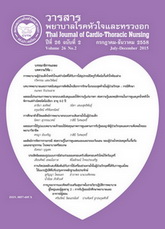การพยาบาลผู้ป่วยเด็กโรคหัวใจแต่กำเนิดที่ได้รับการใส่อุปกรณ์ ปิดรูรั่วที่ผนังกั้นหัวใจห้องล่าง
Keywords:
การพยาบาล, ผู้ป่วยเด็กโรคหัวใจแต่กำเนิด, อุปกรณ์ปิดรูรั่วผนังกั้นหัวใจห้องล่าง, nursing care, congenital heart disease patients, transcatheter closure of ventricular septal defectAbstract
โรครูรั่วที่ผนังกั้นหัวใจห้องล่าง (Ventricular Septal Defect, VSD) เป็นโรคหัวใจแต่กำเนิดที่พบบ่อยที่สุดร้อยละ 25-30 ซึ่งเกิดจากความผิดปกติในการแบ่งห้องหัวใจของทารกขณะอยู่ในครรภ์มารดาทำให้มีรูรั่วที่ผนังกั้นหัวใจห้องล่างซ้ายและขวา เด็กทารกที่เป็นโรคหัวใจ VSD จะมีอาการเหนื่อยหอบและหัวใจเต้นเร็วจากนํ้าท่วมปอดส่งผลให้มีนํ้าหนักตัวน้อยและพัฒนาการช้า ปัจจุบันได้มีการคิดค้นอุปกรณ์ที่ปิดรูรั่วผนังหัวใจห้องล่าง (VSD device closure) วิธีการนี้ไม่ต้องทำผ่าตัดใหญ่ ผู้ป่วยจึงฟื้นตัวได้เร็วขึ้น อย่างไรก็ตามในการรักษาอาจเกิดภาวะแทรกซ้อนทั้งขณะทำการรักษาและหลังการรักษา ดังนั้นพยาบาลต้องพัฒนาศักยภาพด้านการดูแลโดยบูรณาการความรู้เกี่ยวกับโรคหัวใจแต่กำเนิด การสวนหัวใจและการรักษาเพื่อวางแผนการพยาบาลผู้ป่วย VSD ได้อย่างมีประสิทธิภาพ ในบทความนี้จะกล่าวถึงโรครูรั่วที่ผนังกั้นหัวใจห้องล่าง (VSD) อาการและอาการแสดง การรักษาด้วยการใส่อุปกรณ์ปิดรูรั่วที่ผนังกั้นหัวใจห้องล่าง ภาวะแทรกซ้อน การดูแลรักษาพยาบาลในระยะก่อนและหลังการใส่อุปกรณ์ปิดรูรั่วของผนังหัวใจห้องล่าง
Nursing management of transcatheter closure of ventricular septal defect in congenital heart disease patients
Ventricular Septal Defect (VSD) is the most common congenital heart diseases with a share of 25-30% caused by abnormal separation of the two lower chambers of the heart during a fetus phase, resulting in a hole in the wall that separates the right and left ventricles of the heart. Babies with VSD will have excess fluid in their lungs, causing rapid and dyspnea and a fast heartbeat resulting to underweight and slow development. Currently, transcatheter closure of ventricular septal defect invented to avoid open heart surgery; therefore, the patients are likely to recover quickly. However, there may have complications during and post intervention. Consequently, nurses have to improve their nursing competency by integrating knowledge related to congenital heart diseases, cardiac catheterization intervention, and nursing management to provide nursing care to the VSD patients more efficiently. This article presents an overview of Ventricular Septal Defect (VSD), its signs and symptoms, transcatheter closure of VSD, its complications, and nursing care before and after this intervention.
Downloads
How to Cite
Issue
Section
License
บทความนี้ยังไม่เคยตีพิมพ์หรืออยู่ในระหว่างส่งไปตีพิมพ์ในวารสารอื่น ๆ มาก่อน และกองบรรณาธิการขอสงวนสิทธิ์ในการตรวจทาน และแก้ไขต้นฉบับตามเกณฑ์ของวารสาร ในกรณีที่เรื่องของท่านได้ได้รับการตีพิมพ์ในวารสารฉบับนี้ถือว่าเป็น ลิขสิทธิ์ของวารสารพยาบาลโรคหัวใจและทรวงอก






